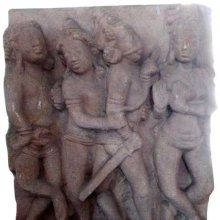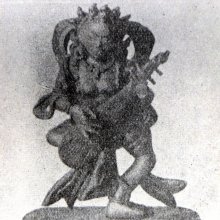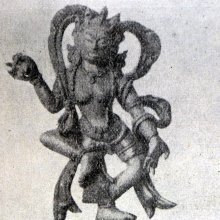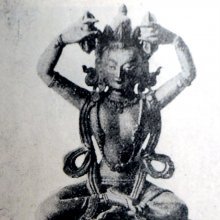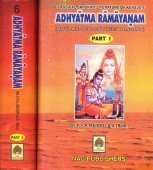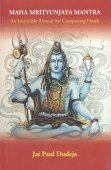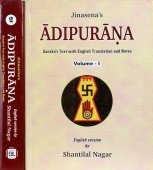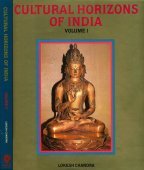Drama: 5 definitions
Introduction:
Drama means something in Hinduism, Sanskrit, the history of ancient India, Hindi. If you want to know the exact meaning, history, etymology or English translation of this term then check out the descriptions on this page. Add your comment or reference to a book if you want to contribute to this summary article.
Alternative spellings of this word include Drum.
Images (photo gallery)
In Hinduism
Purana and Itihasa (epic history)
Source: Shodhganga: Elements of Art and Architecture in the Trtiyakhanda of the VisnudharmottarapuranaDrama (in Sanskrit: Nāṭya) refers to one of the “sixty four kinds of Art”, according to the Kamasutra of Vatsyayana.—Indian tradition, basically includes sixty four Art forms are acknowledged. The history of Indian Art covers approximately five thousand years which presents a rich and almost continuous record. The references of sixty four kinds of Kala (कला, kalā) are found in the Bhagavatapurana, Shaiva-Tantras, Kamasutra of Vatsyayana etc.

The Purana (पुराण, purāṇas) refers to Sanskrit literature preserving ancient India’s vast cultural history, including historical legends, religious ceremonies, various arts and sciences. The eighteen mahapuranas total over 400,000 shlokas (metrical couplets) and date to at least several centuries BCE.
India history and geography
Source: Cologne Digital Sanskrit Dictionaries: Indian Epigraphical GlossaryDrama.—(EI 23), same as dramma. Note: drama is defined in the “Indian epigraphical glossary” as it can be found on ancient inscriptions commonly written in Sanskrit, Prakrit or Dravidian languages.
--- OR ---
Drama.—same as dramma. Note: drama is defined in the “Indian epigraphical glossary” as it can be found on ancient inscriptions commonly written in Sanskrit, Prakrit or Dravidian languages.
Source: Singhi Jain Series: Ratnaprabha-suri’s Kuvalayamala-katha (history)Drama was part of the festivities such as the Kaumudi-Mahotsava festival celebrated on the Śaratpaurṇimā in ancient India, as vividly depicted in the Kathās (narrative poems) such as Uddyotanasūri in his 8th-century Kuvalayamālā (a Prakrit Campū, similar to Kāvya poetry).—Page 103.15: Here is a reference of the Kaumudī-Mahotsava celebrated in a the city of Campā on the Śaratpaurṇimā day (line 32). It was attended by great festivities of music, dance and drama. In the city-square a Naṭa gave demonstration of his dance. The Naṭa is called Bharata-putra, i.e., the follower of Bharata or an adept in Nāṭya-śāstra.

The history of India traces the identification of countries, villages, towns and other regions of India, as well as mythology, zoology, royal dynasties, rulers, tribes, local festivities and traditions and regional languages. Ancient India enjoyed religious freedom and encourages the path of Dharma, a concept common to Buddhism, Hinduism, and Jainism.
Languages of India and abroad
Sanskrit dictionary
Source: Cologne Digital Sanskrit Dictionaries: Edgerton Buddhist Hybrid Sanskrit DictionaryDrama (द्रम).—[, Kāraṇḍavvūha 3.6, read Druma, q.v.]
Sanskrit, also spelled संस्कृतम् (saṃskṛtam), is an ancient language of India commonly seen as the grandmother of the Indo-European language family (even English!). Closely allied with Prakrit and Pali, Sanskrit is more exhaustive in both grammar and terms and has the most extensive collection of literature in the world, greatly surpassing its sister-languages Greek and Latin.
Hindi dictionary
Source: DDSA: A practical Hindi-English dictionary1) Ḍrama (ड्रम) [Also spelled drum]:—(nm) a drum.
2) Ḍrāmā (ड्रामा):—(nm) a drama.
...
See also (Relevant definitions)
Starts with: Dramaka, Dramatic performance, Dramatic style, Dramaturgy, Dramavyadhi.
Ends with: Abhyudrama, Arkacandrama, Bhadrama, Bodhidrama, Camdrama, Candrama, Chandrama, Dandrama, Gondrama, Greek drama, Jagadrama, Kshudrama, Panciyaka-drama, Pataladrama, Sadrama, Sanskrit drama, Shrijagadrama, Vasidrama.
Full-text (+1799): Nataka, Natya, Rupaka, Purvaranga, Abhijnanashakuntala, Ajjuka, Dasharupaka, Rasaprabandha, Candakaushika, Prakarana, Arthaprakriti, Trotaka, Prakari, Prasthana, Kelikila, Gitagovinda, Artika, Bharatashastra, Anargharaghava, Maharupaka.
Relevant text
Search found 142 books and stories containing Drama, Ḍrāmā, Ḍrama; (plurals include: Dramas, Ḍrāmās, Ḍramas). You can also click to the full overview containing English textual excerpts. Below are direct links for the most relevant articles:
Puppetry in Assam (by Gitali Saikia)
Classification of Folk drama < [Chapter 1]
Puppetry and Folk Dramas of Assam < [Chapter 6]
Characteristics of Folk drama < [Chapter 1]
Dasarupaka (critical study) (by Anuru Ranjan Mishra)
Introduction to the Vyāyoga type of Drama < [Chapter 5 - Vyāyoga (critical study)]
Purpose of the Thesis < [Introduction]
Western classical dramatic tradition < [Introduction]
Gati in Theory and Practice (by Dr. Sujatha Mohan)
Sanskrit dramas and their performance < [Chapter 3 - Application of gati in Dṛśya-kāvyas]
Gati in contemporary Sanskrit theatre < [Chapter 4 - Practice of Gati]
Secondary sources on Nāṭya < [Introduction]
Vishnudharmottara Purana (Art and Architecture) (by Bhagyashree Sarma)
1.2. Characteristic Features of Sanskrit Drama < [Chapter 3 - Drama and Dance]
1.3. Elements of Drama (g): Characters < [Chapter 3 - Drama and Dance]
1.3. Elements of Drama (a): Acting < [Chapter 3 - Drama and Dance]
The South Indian Stage < [March, 1928]
Theories of the Drama: Aristotle vs. the Indian Theorists < [July-August 1931]
The Stage in Maharashtra < [September 1937]
Kuntaka’s evaluation of Sanskrit literature (by Nikitha. M)
Conclusion to Chapter 4 < [Chapter 4 - Kuntaka’s evaluation of Sanskrit Plays of other Poets]
Introduction < [Chapter 4 - Kuntaka’s evaluation of Sanskrit Plays of other Poets]
9. Udāttarāghava in Kuntaka’s treatment < [Chapter 4 - Kuntaka’s evaluation of Sanskrit Plays of other Poets]
Related products
